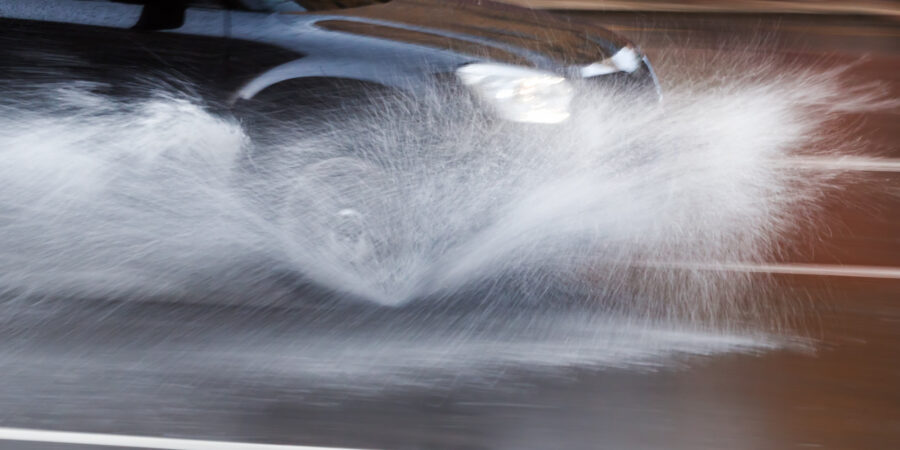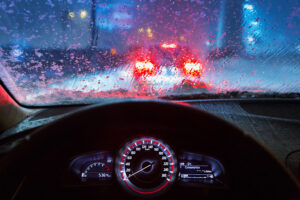Many Auto Accidents Are Weather-Related
According to the Federal Highway Administration, there are close to 5.9 million car accidents every year in this country. Of these, around 21% are weather-related. Data from the National Highway Traffic Safety Administration shows that weather-related accidents kill an average of 5,000 people and injure over 418,000.
Now, weather-related accidents cover many scenarios, including those that take place because of rain, snow, fog, and heavy winds. Rain, however, had the largest part to play with some 46% of weather-related accidents occurring during rainfall and 70% arising on wet pavement. Contrast this with the 18% that occur in snow and 13% that take place on icy pavement.
Accident Risk Increases in Rain
A 2019 study from the North Carolina Institute for Climate Studies analyzed the link between rainy weather and car accidents and found that, overall, the risk for a fatal accident increases 34% when there is a “precipitation event.” Even if the rain is nothing more than a drizzle, the authors say that the risk goes up 27%.
Why Is Driving in Rain So Dangerous?
This brings us to the question of why driving in rain can be so dangerous and even deadly. The answer lies not in one factor but in the combination of many. This will be good to keep in mind because if you were in an accident in heavy rain and you believe that the other side was at fault, you will likely need a car accident attorney to help you bring all the factors together in presenting your case.
The Risk of Hydroplaning
Your tires lose traction when they are wet, which means they don’t grip the surface of the road as well as they should. If you drove slowly enough, the tires will scatter the water, and you should be able to maintain contact with the road. But the faster you drive, the less time there is for the tires to do this.
This leads to a condition called hydroplaning. As the tires hit the water and cause pressure to build up, water is sent under the tires and creates a thin film between the tires and the road. So after driving a while in the rain, your tires may not actually be touching the road. The situation becomes worse if your tires have worn tread. In any event, you will be much more likely to lose control of your steering and brakes. Even a slight turn could cause your car to skid.
Longer Braking Distances
By braking distance, we mean the distance it takes for a car to come to a complete stop. This distance can be influenced by a number of things, such as your vehicle’s size, the amount of wear on its tires, the condition of the pavement, and your speed. You can see, then, that rain will have an impact on this. In fact, heavy rain can double your braking distance. If you don’t apply the brakes sooner, then you’re liable to cause a rear-end collision.
Lack of Visibility
Before rain hits the ground, it can obscure drivers’ vision even when the windshield wipers are in use. California law requires drivers to turn on their headlights when adverse weather forces them to use the windshield wipers, but even with this combination of headlights and wipers, your vision may become impaired on account of the light being reflected and scattered in the rain. And naturally, drivers may become so focused on what’s ahead of them that they forget to use their peripheral vision.
Puddles May Hide Additional Dangers
Water on the road can hide hazards that you would otherwise swerve out of the way of, such as road debris and potholes. Potholes, in particular, are not something you want to speed over because they can affect your vehicle’s wheel alignment and damage the struts, axles, and other components.
How to Avoid a Car Accident in the Rain
Though the rain may present a myriad dangers, it can’t always be used as an excuse when drivers get in a car accident. The fact is that most accidents, in rain or shine, are the result of negligence. Take the following safety tips into account, and you will drastically reduce your chances of a crash in heavy rain.
Slow Down
This may be the most important tip of all. As we said above, the faster you go, the less traction you have on the road because of the water that collects between the tires and the pavement. The general rule is to cut your speed by one-third in wet weather. By going slower, you not only control your vehicle better but also give yourself more time to react to potential hazards: pedestrians darting out, debris on the road, etc. Make sure you turn on your headlights together with your windshield wipers.
Increase Your Following Distance
At the same time as you lower your speed, increase your following distance from the car in front of you. On the freeway, for instance, the recommended following distance is four seconds in normal weather but six seconds in rain. To determine your following distance, simply pick a point up ahead like a road sign, and when the car in front passes it, count how many seconds go by before you pass it. A greater following distance makes up for the greater braking distance that you will experience in rain.
Brake Slowly
Do not brake suddenly, or the wheels may lock up and you may skid. Actually, any sudden movements, like sudden turning and harsh acceleration, can cause you to lose control. Rather, take your time in braking, occasionally letting your foot off the brake. Remember that your braking distance will increase whether it’s light or heavy rain.
Avoid Turning on the Brights
We mentioned that lights can be reflected and scattered in the rain and impair vision: both yours and other drivers’. For this reason, don’t turn on the brights.
Check for Good Tire Tread
Tread depth should be at least two inches. The usual way to check your tread is to put a penny upside down into one of the grooves of the tire: if Lincoln’s entire head is visible, you will want to replace your tire. Many tires come with a wear indicator built into them, too. If the tread has worn down to a place below these little marks, then you must replace the tires.
Plan Ahead When Possible
Checking your tires is just one way to prepare for a drive in wet weather. We also suggest giving yourself more time to get to your destination because, for one thing, you may meet with traffic delays. Besides that, when you’re not rushed, you don’t feel so compelled to speed or make other unsafe decisions. In addition, turn on the defroster before heading out on the road; that will be one less device to be distracted by on the road.
Postpone Your Trip If Possible
The first 10 to 15 minutes of rainfall pose the greatest threat to drivers because that’s the time when the rain mixes with the oils on the road and creates a slippery surface. After 15 minutes, the oils get washed away. So if you’re about to go out and it starts to rain, consider waiting for 10 or 15 minutes if possible.
Your Go-To Car Accident Attorney
You were in a collision when there was heavy rain, and you believe that the other driver had acted negligently. JT Legal Group is here to protect your rights and represent you as you move forward with a case against that driver. We operate on a contingency fee basis: you don’t pay if we don’t win. Contact our California office today to schedule a free, no-obligation consultation.



